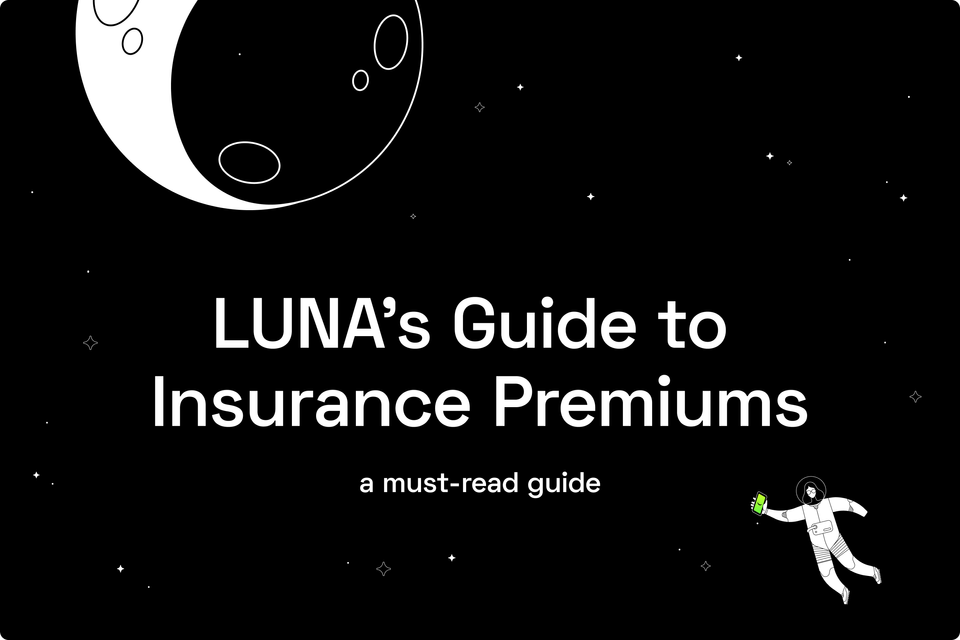LUNA’s Guide to Insurance Premiums: A Must-Read Guide


Have you ever wondered why your car insurance rates are what they are? Understanding insurance premiums is crucial if you want to make informed decisions about your coverage. It's important to know how insurance companies calculate premiums based on a variety of different factors. That's where LUNA's expertise comes in handy.
With LUNA's Guide to Insurance Premiums, you can gain a comprehensive understanding of how insurance costs are determined. This guide will help you navigate the maze of car insurance premiums, from calculating premiums to the key factors that impact insurance costs.
By the end of this guide, you'll be able to make better decisions about your coverage and potentially save money on your car insurance premiums. So whether you're a new driver or a seasoned one, take the time to read LUNA's Guide to Insurance Premiums. It's a must-read guide for anyone looking to get the most out of their car insurance coverage.
Section 1: Basics of Insurance Premiums

Insurance premiums can be a confusing concept to anyone who has ever shopped around for auto insurance. Simply put, an insurance premium is the amount of money you pay to your insurer in exchange for coverage. The cost of insurance premiums has a lot to do with risk assessment.
Insurance companies use complex algorithms and historical data to calculate your car insurance rates. These rates can be influenced by several factors such as your driving record, your age, the type of car you drive, and where you live. More cautious drivers and those with a clean driving record are deemed low-risk and typically pay less in insurance premiums than high-risk drivers.
While it may seem like insurance premiums are set in stone, there are ways to lower your costs. Increasing your deductible or opting for a usage-based insurance program, for instance, can help you save money. Understanding the factors that affect your insurance premiums can help you make informed decisions when it comes to choosing the right coverage for your needs.
Section 2: Factors Affecting Your Insurance Premium

Picking an insurance policy can be a daunting task, with an overwhelming amount of factors affecting insurance premiums. The most significant factors effecting car insurance rates are age, driving history, and vehicle type. According to the Insurance Information Institute, factors such as age and gender can play a big part in calculating premiums.
For instance, statistics show that teen drivers, specifically males, are more likely to get into accidents and therefore pay higher insurance premiums than their female peers. Additionally, those with a history of violations and accidents can face higher insurance costs due to their increased risk of getting into future accidents. Vehicle type also plays a significant role in determining insurance costs with sports cars having higher premiums than minivans.
It is important to keep in mind that calculating premiums is far more complicated than simply looking at these three factors. However, by understanding some of the most influential insurance cost factors, anyone can make an informed decision about selecting the right coverage for their needs.
Section 3: Understanding theeRole of Deductibles

Insurance is often associated with confusing terms, and one such term is the deductible. A deductible is the amount you pay out of pocket before your insurance covers the remaining cost. It’s important to understand how choosing different deductible amounts can affect your insurance premiums or car insurance rates. The higher the deductible, the lower the insurance premium you pay.
However, if you select a lower deductible, your premium cost will increase. Calculating premiums is an important factor when considering different deductibles. It is crucial to decide on an affordable deductible amount that doesn’t break the bank. Factors such as driving history and car make/model also contribute to the insurance cost. To select the appropriate deductible for your individual needs you should take into consideration how often you drive, the car’s value, your savings, and how often you need auto insurance.
A higher deductible could work for someone who has a car that’s less-valuable, while someone with a more expensive car may require a lower deductible. On the other hand, choosing a lower deductible could be better for someone who often travels long distances and requires more coverage. One tip to consider is to weigh the amount of the deductible you pay versus the amount of savings you receive in your annual premium. With some research and thought, you can select an appropriate deductible that fits your individual needs while keeping insurance premiums at a comfortable rate.
Section 4: Discounts and How to Qualify for Them

As you sit down to calculate your insurance premiums, it's easy to feel overwhelmed by the various factors that contribute to the final cost. However, understanding which discounts you qualify for can significantly reduce your car insurance rates.
Safe driver discounts are among the most common, awarded to policyholders who have maintained a clean driving record for a certain number of years. Multi-car discounts can also result in substantial savings for families with multiple vehicles insured under the same policy. Some insurance providers offer discounts for policyholders who have completed a defensive driving course, while others reward customers who bundle different insurance policies together.
Many providers also offer loyalty discounts for long-term customers. By taking advantage of these opportunities and qualifying for discounts, you can save a considerable amount on your insurance premiums. Don't hesitate to ask your insurance provider about available discounts – after all, every little bit helps.
Section 5: Comparing Insurance Quotes

When it comes to insurance premiums, understanding how to navigate and compare quotes is crucial to ensuring you receive the best rates for the coverage you need. However, it's not just about finding the lowest prices, but also about understanding the nuances of coverage details. By taking a closer look at the specifics of each quote, you can gain a better understanding of what is actually included in the policy, which can significantly impact the ultimate insurance cost factors.
For instance, while one insurance provider may offer a lower rate on their car insurance rates, they may not provide the same level of coverage as another provider at a slightly higher premium. Calculating premiums shouldn't be a decision based solely on numbers, but rather, on an informed comparison that takes into account all the various factors that contribute to the overall cost of insurance.
This is especially true when considering coverage for your most valuable assets, like your vehicle or home. So the next time you're searching for insurance, remember to take a closer look at the coverage details, and not just the prices, for a complete picture of what you're paying for.
Comparing insurance quotes can be overwhelming, especially with so many factors to consider. That's where LUNA comes in to make the process much easier for you. LUNA's platform offers a range of insurance quotes for you to compare and choose the best coverage that fits your budget and needs.
Section 6: The Impact of Policy Adjustments on Premiums

Coverage changes, such as adding drivers or vehicles, can have a significant impact on insurance premiums. It is essential to keep in mind that the insurance company calculates the rates based on several factors, including the vehicles' make and model, the age and driving record of drivers, and the number of accidents in the past.
When you add a new vehicle or driver to your policy, it might affect the policy's risk profile. This change can increase or decrease the premiums you pay. For example, adding a young driver with minimal driving experience can increase the insurance costs, as younger drivers are statistically more likely to get into an accident.
On the other hand, adding a car that is safer or less expensive to repair and maintain can lower the premiums. The insurance company calculates premiums based on risk, and any change in coverage can modify this calculation, ultimately impacting insurance premiums. It is wise to consult with your insurance representative to ensure that you get a fair premium rate for your changing coverage needs. Remember, by educating yourself about the insurance cost factors, you can take a more active role in calculating premiums and make informed decisions accordingly.
LUNA is revolutionizing the insurance industry with its innovative app and expert services. This comprehensive solution simplifies the insurance process by providing quotes, comparing rates, and saving an average of $597/year on auto insurance. LUNA ensures transparency, hassle-free management, and privacy protection for clients. With real-time tracking and a user-friendly mobile app, insurance has never been more accessible. Evaluate policy changes and calculate premiums with ease using LUNA's advanced features.
Section 7: Special Considerations for High-Risk Drivers

There's no doubt that car insurance premiums can take a big chunk out of your budget, especially if you're considered high-risk. But what exactly does it mean to be a high-risk driver? Factors such as a poor driving record, a history of accidents or DUIs, or even your age can all contribute to being labeled as high-risk. And unfortunately, this label can mean higher car insurance rates. But don't let that discourage you - there are options available for high-risk drivers.
Insurance companies use a variety of factors to calculate premiums, including your driving record, the type of car you drive, and even your credit score. By understanding these insurance cost factors, you can work on improving your risk profile and potentially secure more reasonable premiums. Additionally, there are insurance companies that specialize in insuring high-risk drivers. While these policies may come with higher premiums, they offer the necessary coverage for drivers who may not be able to acquire it elsewhere. With a little knowledge and research, you can take steps to mitigate the effects of being a high-risk driver and find the best insurance options for your needs.
Section 8: LUNA's Expertise

Navigating the often-complicated world of insurance premiums can be daunting, especially when trying to find the best solutions for your car insurance rates. LUNA, however, offers unparalleled expertise in helping customers find optimal solutions to their insurance needs. With years of experience in calculating premiums and knowledge of the insurance cost factors that impact them, LUNA's team of experts can guide you through the process with confidence. But don't just take our word for it.
Our satisfied customers have expressed their appreciation for LUNA's dedication and effectiveness in finding premium solutions that work for them. At LUNA, we believe in providing unparalleled customer service and making the insurance process as seamless and accessible as possible. So don't hesitate to reach out to us for help in navigating the world of insurance premiums.
Understanding and managing insurance premiums is crucial in ensuring financial stability and peace of mind when purchasing car insurance. By knowing the basics of insurance premiums and the factors that affect car insurance rates, we can make informed decisions about our insurance policies.
Additionally, understanding how deductibles function and qualifying for discounts can help reduce insurance costs. It is also important to compare insurance quotes before making a final decision, as policy adjustments can have a significant impact on premiums. High-risk drivers need to take special considerations in managing their insurance premiums, as they may face higher rates.
Finally, LUNA offers dedicated resources to help navigate insurance cost factors and calculate premiums. By using our expert resources and following these tips, we can all take control of our insurance premiums and find affordable and comprehensive car insurance coverage.
